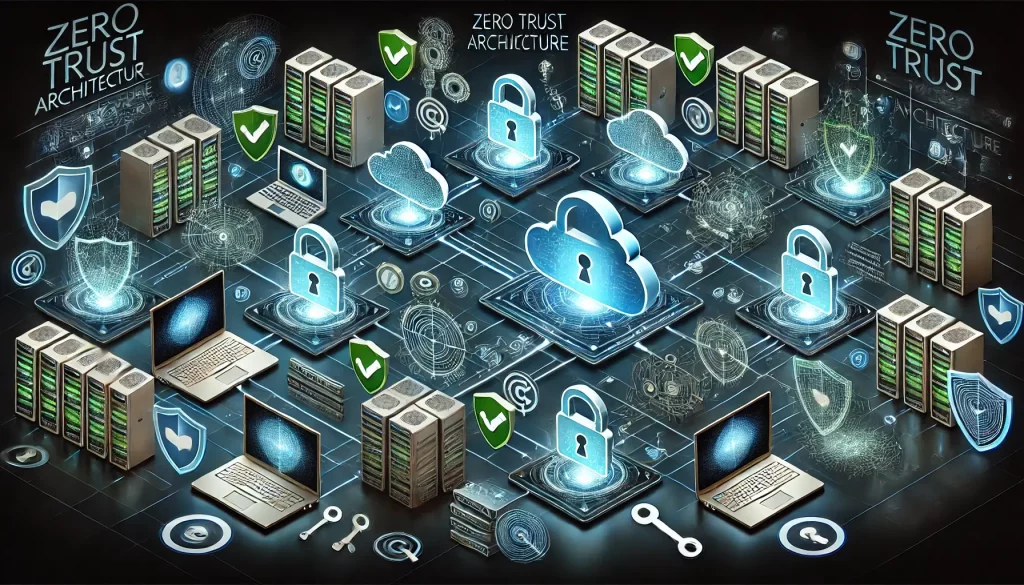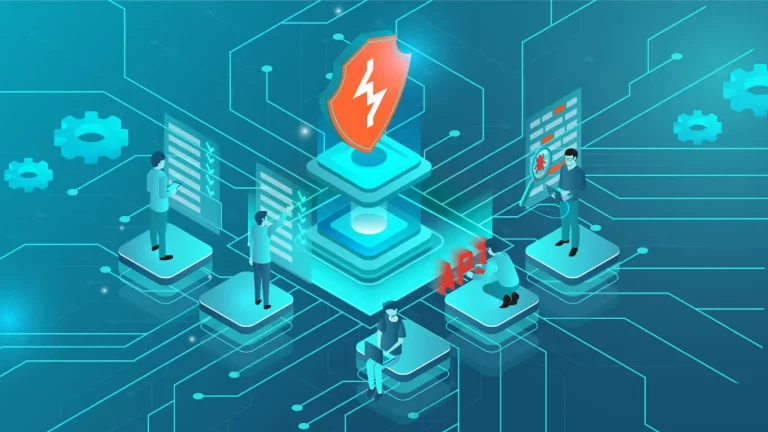Threats are more sophisticated and pervasive than ever before, traditional security models based on perimeter defenses are no longer adequate.
Zero Trust Architecture (ZTA) has emerged as a comprehensive solution to address today’s complex security challenges. This article will dive deep into what Zero Trust is, why it’s vital for organizations of all sizes, and the practical strategies for implementing it effectively.
Whether you’re a CISO, IT manager, or a business leader, understanding ZTA will be crucial for safeguarding your digital assets.
What is Zero Trust?
Zero Trust is a cybersecurity model that operates on the principle of “never trust, always verify.” Unlike traditional security frameworks that rely on securing the network perimeter, Zero Trust assumes that threats can come from both outside and inside the network.
Therefore, no entity—whether it’s a user, device, or application—is trusted by default. Instead, access is granted based on continuous verification, least-privileged access principles, and strict authentication policies.
Core Principles of Zero Trust:
- Assume Breach: Operate as though the network is already compromised.
- Least Privilege Access: Grant users and devices only the minimum level of access required to perform their tasks.
- Continuous Verification: Constantly monitor and verify all access requests regardless of where they originate.
- Micro-Segmentation: Divide the network into smaller, isolated zones to limit the lateral movement of attackers.
- Strong Authentication: Implement multi-factor authentication (MFA) for users and devices accessing sensitive resources.
Why Zero Trust is Important in Today’s Cybersecurity Landscape
The traditional perimeter-based security model—focused on securing the boundaries of an organization—worked well when all assets and users were on-premises. However, in today’s world of cloud computing, remote work, and mobile access, this model has become obsolete.
Threat actors are increasingly using sophisticated methods like phishing, insider threats, ransomware, and supply chain attacks to bypass perimeter defenses. Zero Trust addresses these challenges by focusing on identity, data protection, and continuous monitoring.
Key Reasons for Adopting Zero Trust:
- Increased Attack Surface: With the rise of cloud services, remote work, and IoT devices, the network perimeter is blurred. Zero Trust secures every connection, regardless of its source or destination.
- Preventing Lateral Movement: Once inside a network, attackers can move from one system to another. Zero Trust limits lateral movement by enforcing micro-segmentation and ensuring that even internal systems must authenticate with one another.
- Protection Against Insider Threats: Whether malicious or accidental, insider threats pose a significant risk. Zero Trust ensures that even trusted employees are subject to the same verification and access policies as external users.
- Compliance and Data Protection: Many regulations like GDPR and HIPAA require strict data security measures. Zero Trust helps organizations meet these requirements by controlling who can access sensitive data and ensuring that access is properly audited.
- Adapting to Modern Work Environments: As more employees work remotely and use personal devices, Zero Trust secures access to enterprise systems without relying on VPNs or firewalls, ensuring that only authorized users with secure devices can connect.
Practical Strategies for Implementing Zero Trust Architecture
Transitioning to a Zero Trust Architecture is a multi-phase process that requires careful planning and alignment with your organization’s specific needs. Below are practical strategies that can help you implement Zero Trust effectively.
1. Assess the Current State of Your Security Infrastructure
Before you begin implementing Zero Trust, you need to conduct a comprehensive audit of your current infrastructure. Understand the following:
- User Access Patterns: How do users access your network? Are there specific behaviors or risky access points?
- Asset Inventory: Catalog all devices, users, applications, and data on the network. Ensure that you have visibility into where your sensitive data resides.
- Network Traffic: Identify how data flows across your network, especially between high-value assets.
This audit will help identify gaps and vulnerabilities that need to be addressed as part of your Zero Trust strategy.
2. Implement Strong Identity and Access Management (IAM)
Zero Trust starts with identity verification. Every entity that attempts to access resources—whether it’s a human user, device, or application—must be properly authenticated and authorized.
- Multi-Factor Authentication (MFA): Enforce MFA across all access points. MFA ensures that even if credentials are stolen, attackers cannot easily compromise systems.
- Single Sign-On (SSO): Simplify access management by implementing SSO. Users only authenticate once, but their credentials are used for multiple applications, making it easier to track access.
- Role-Based Access Control (RBAC): Define roles within your organization and grant permissions based on the principle of least privilege. Users should only have access to the systems they need for their job.
3. Enforce Least Privilege and Just-in-Time Access
Limiting the access rights of users and devices is critical in a Zero Trust environment.
- Least Privilege Access: Ensure that users and applications can only access the specific resources they need and nothing more. For example, if an employee only needs access to HR data, they shouldn’t have access to the entire network.
- Just-in-Time Access: Use time-limited access tokens that expire after a set duration. This ensures that even authorized access isn’t permanent and minimizes the attack surface if credentials are compromised.
4. Micro-Segmentation and Network Isolation
Micro-segmentation is the practice of breaking your network into smaller, isolated segments. Each segment is protected with its own access controls and authentication mechanisms, limiting an attacker’s ability to move laterally within your network.
- Define Security Zones: Create distinct zones for sensitive systems, public-facing services, and user workstations. Apply strict access controls between each zone.
- East-West Traffic Inspection: Monitor all internal traffic (East-West traffic) to detect suspicious activity. This allows you to identify threats that might be moving laterally within the network.
5. Continuous Monitoring and Threat Detection
In a Zero Trust environment, continuous monitoring of all systems and network activities is crucial. You need to be able to detect anomalies and respond to threats in real-time.
- Security Information and Event Management (SIEM): Implement SIEM systems to collect and analyze security-related data from across your network. SIEM tools can correlate data to detect threats early.
- Behavioral Analytics: Use machine learning and behavioral analytics to identify abnormal behavior, such as users accessing systems they don’t typically interact with.
- Automated Incident Response: Deploy automated tools to respond to security incidents quickly. For example, if an anomaly is detected, access for the affected user can be immediately revoked, and an alert can be triggered for investigation.
6. Data Encryption and Endpoint Security
Encrypt data both at rest and in transit to ensure that even if an attacker intercepts the information, it is unusable without the decryption keys. Endpoints, which are often the weakest link, should also be hardened with antivirus software, firewalls, and patch management to reduce vulnerabilities.
- Data Encryption: Encrypt all sensitive data using industry-standard algorithms like AES-256. Encryption should apply to data stored on servers, databases, and backups.
- Endpoint Security: Ensure that all endpoints (laptops, mobile devices, IoT devices) are updated regularly with the latest security patches. Use device attestation to verify the security posture of a device before granting access.
Common Challenges and How to Overcome Them
1. Legacy Systems Integration
Many organizations struggle with integrating Zero Trust into legacy IT environments. A hybrid approach is often necessary, where legacy systems can be isolated within micro-segments to reduce risk while slowly being upgraded or replaced.
2. User Experience vs. Security
Zero Trust can be perceived as cumbersome for end-users due to constant authentication prompts and access verifications. Implementing SSO and using advanced authentication methods like biometric verification can mitigate these issues while maintaining strong security.
3. Cost and Complexity
The initial investment in Zero Trust can be high, especially for large organizations. To overcome this, a phased approach should be adopted, starting with high-priority areas and gradually expanding Zero Trust across the organization.
Conclusion: The Future of Zero Trust
Zero Trust is not just a security model—it’s a mindset shift that emphasizes data security, continuous monitoring, and strict access controls. With the right strategy, implementing Zero Trust can significantly reduce your organization’s attack surface, protect against insider and external threats, and ensure compliance with data privacy regulations.
As more companies adopt cloud computing, remote work, and distributed environments, Zero Trust will become the gold standard for securing digital assets. For organizations yet to begin this transition, now is the time to evaluate how Zero Trust can be incorporated into your security architecture to stay ahead of evolving cyber threats.
By adopting Zero Trust, you’re not only protecting your business today but also future-proofing your cybersecurity strategy for tomorrow.





